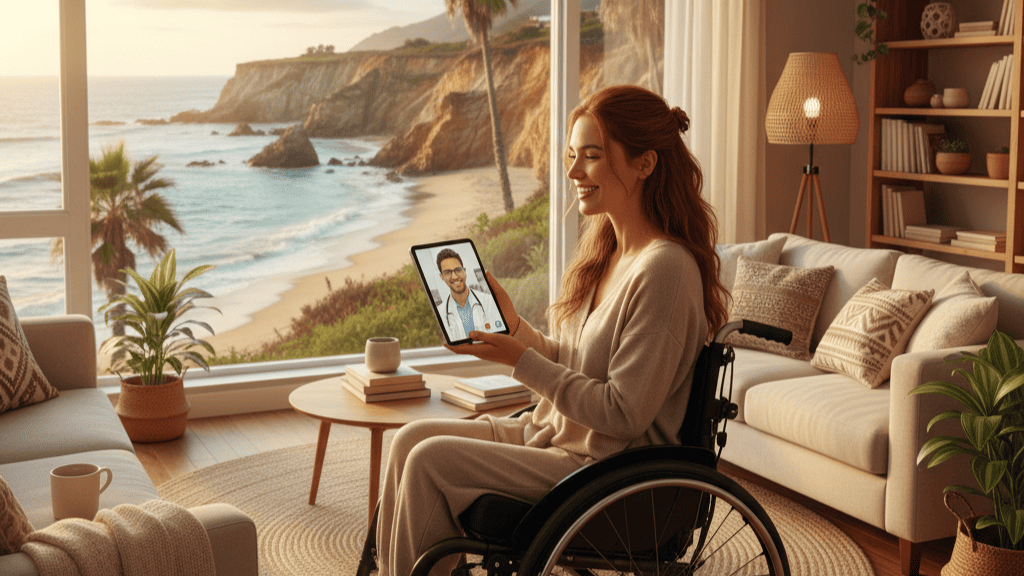Telehealth in Ramsoft with Curogram
💡 Telehealth in Ramsoft helps radiology networks connect with patients faster and more easily. Radiologists and referring providers meet with...
8 min read
Gregory Vic Dela Cruz : Nov 12, 2025 2:00:00 PM

Conduct HIPAA-compliant video consultations.
Share imaging results securely in real time.
Enable remote follow-ups without travel delays.
Integrate seamlessly into Exa scheduling and patient workflows.
Enhance access, efficiency, and satisfaction across imaging centers.
Curogram’s telehealth solution helps radiology teams provide accessible and secure virtual care.
Radiology plays a vital role in patient diagnosis and treatment planning. However, traditional communication gaps often delay critical care.
Patients frequently wait days—or even weeks—for imaging follow-ups or result discussions. This is often due to schedule conflicts, travel time, or limited access to specialists. Unfortunately, this model no longer meets the standard of modern care.
Telehealth in Konica Minolta Exa bridges that gap. It connects radiologists, referring physicians, and patients through secure, virtual communication channels. With Curogram’s integrated telehealth solution, radiology centers can conduct HIPAA-compliant video consultations. This lets clinics share imaging results instantly and provide consults from any device. Plus, it requires no app downloads or complex logins.
This article explores why telehealth matters in radiology. We'll discuss the measurable benefits imaging centers achieve after implementing the solution. You’ll see examples of radiology practices using telehealth integration to streamline telemedicine.
Want to help redefine what patient-centered radiology looks like for your clinic? Keep reading.
Follow-up imaging consultations are crucial for patient understanding and treatment adherence, yet many radiology centers face significant no-show rates for in-person discussions. Patients often skip follow-up appointments due to distance, mobility issues, or scheduling conflicts. For rural communities and elderly populations, these barriers can lead to delayed diagnoses and poor continuity of care. As a result, both patient outcomes and provider efficiency suffer.
Telehealth in Konica Minolta Exa addresses these challenges by enabling secure virtual consultations that connect patients and radiologists instantly. With video-based discussions, physicians can review imaging results, explain findings, and coordinate treatment plans in real time. This direct communication not only improves comprehension but also reduces the likelihood of missed follow-ups. For patients with chronic conditions requiring regular scans, virtual appointments make it easier to stay engaged with their care team.
Referring physicians also benefit from this technology. Faster, more accessible consultations support timely clinical decisions and better collaboration across departments. For example, orthopedic surgeons can discuss MRI findings with radiologists during the same day, accelerating surgical planning and reducing delays in patient care. Additionally, Exa’s telehealth tools allow referring providers to access imaging results securely, ensuring coordinated communication without compromising privacy.
Beyond convenience, telehealth expands the reach of radiology centers. Clinics in smaller towns or suburban areas can now connect with patients and specialists across regions. Instead of losing patients to distance or scheduling barriers, practices can retain engagement through flexible, digital communication. This modern approach strengthens relationships, improves compliance, and aligns radiology practices with the broader movement toward hybrid and virtual healthcare delivery.
Curogram’s integration brings seamless telehealth functionality directly into Konica Minolta Exa’s workflow. Built with HIPAA compliance and healthcare security in mind, it allows radiology centers to conduct video consultations without external software or complicated installations. Patients receive a secure link via text or email that opens instantly in their browser, creating a frictionless virtual experience that anyone can access.
Each session is encrypted end-to-end to protect patient health information. There are no downloads, plug-ins, or credentials to manage—just a simple, one-click connection that’s optimized for desktops, tablets, and smartphones. This simplicity reduces IT dependency while improving participation rates among patients and referring physicians. As a result, clinics can expand telehealth availability to any patient population with minimal support effort.
The Exa virtual care integration also connects with the system’s scheduling and patient communication modules. Radiology staff can manage appointments, send reminders, and launch consultations all within Exa’s platform. This centralized workflow prevents duplication and keeps patient information unified across departments. Notes and documentation from telehealth sessions are automatically saved within Exa, ensuring continuity between virtual and in-person care.
In addition to patient consultations, radiologists can use Curogram’s telehealth tools to collaborate internally. Specialists across different locations can review cases together via secure video conferencing, improving interpretation accuracy and peer-to-peer communication. This capability is particularly valuable for multi-site imaging networks or hospital-based radiology groups that rely on efficient collaboration for timely reporting and diagnosis.
Through Curogram, Exa’s telehealth functionality transforms radiology communication. It’s a comprehensive, compliant solution that enhances accessibility, reduces patient barriers, and strengthens inter-provider collaboration—all within the familiar Exa ecosystem.

Telehealth in Konica Minolta Exa increases patient compliance by removing barriers to follow-up care. Many patients skip result discussions due to travel distance, scheduling conflicts, or mobility limitations. Virtual consultations make it easier for patients to stay connected with their care team without leaving home. This accessibility strengthens engagement and encourages patients to follow through on post-imaging recommendations.
Curogram’s integration allows radiologists to deliver results and hold discussions immediately after imaging exams. Physicians and patients no longer wait for in-person meetings to interpret findings. With real-time access to imaging results, treatment planning can begin faster. This immediate coordination leads to better outcomes and improved trust between providers and patients.
Telehealth eliminates geographical limitations that traditionally restrict care delivery. Imaging centers can now reach patients in remote, rural, or underserved areas. Radiologists can also collaborate across different facilities without physical travel. This expanded accessibility ensures consistent care and diagnostic accuracy regardless of location.
Radiology is inherently collaborative, often requiring multidisciplinary communication. Curogram’s Exa virtual care platform enables radiologists to hold secure, real-time case discussions with referring physicians and specialists. This integrated communication improves diagnostic quality and speeds up clinical decisions. The result is better coordinated care and stronger professional relationships.
Modern patients expect convenient, technology-driven healthcare. Providing online imaging consults meets that demand by offering flexibility and comfort. Patients appreciate being able to review results from home without waiting days for appointments. This convenience translates to higher satisfaction scores and stronger patient loyalty.
All telehealth sessions conducted within Exa are automatically logged and stored securely for audit purposes. This creates a digital paper trail that supports HIPAA and SOC 2 compliance. Administrators no longer have to manually document virtual visits or retrieve external records. The system ensures all communications remain consistent, traceable, and compliant.
Virtual consultations reduce the need for physical exam room usage and front-desk scheduling strain. Radiology teams can manage more patient interactions without expanding physical space or staff hours. Patients save money on travel and time off work, while clinics reduce operational overhead. The efficiency leads to measurable ROI and improved profitability.
With virtual appointments integrated directly into Exa’s workflow, radiology centers can handle more patient interactions per day. Radiologists can consult with multiple patients back-to-back, improving overall productivity. Despite the higher volume, communication remains personalized and secure. This efficiency helps balance workload and supports sustainable growth.
Telehealth in Konica Minolta Exa allows practices to track every follow-up consultation within one system. Curogram’s dashboard displays appointment completion rates, ensuring no patient slips through the cracks. Automated notifications remind patients of scheduled virtual visits, minimizing missed sessions. This structure enhances accountability for both staff and patients.
With integrated telehealth, radiology centers can maintain consistent communication between exams. Patients can discuss progress, address concerns, and clarify imaging instructions from anywhere. This ongoing engagement supports long-term health monitoring and chronic condition management. It strengthens the bond between the imaging center and its patient base.
Virtual access reduces the likelihood of last-minute cancellations. Patients who might miss an appointment due to transportation or scheduling issues can easily attend online. For radiology departments, this consistency stabilizes daily schedules and improves operational flow. Fewer no-shows directly boost revenue and productivity.
Curogram’s telehealth module connects directly to Exa’s scheduling and patient management tools. This integration ensures that virtual visits are recorded alongside imaging exams and reports. Staff can launch, manage, and document video sessions without leaving the Exa platform. The unified workflow minimizes training needs and reduces friction across departments.
Telehealth gives radiologists the ability to work remotely while maintaining full visibility of patient interactions. Technologists can coordinate case reviews or training sessions virtually across multiple sites. This flexibility improves work-life balance for staff and enhances collaboration across locations. It also supports workforce adaptability in times of high demand or staffing challenges.
Referring physicians prefer working with imaging centers that provide accessible communication channels. Telehealth consultations in Exa allow doctors to connect instantly with radiologists for case reviews or second opinions. This real-time collaboration builds trust and strengthens referral partnerships. Over time, it leads to more consistent referrals and stronger professional networks.
Adopting telehealth prepares imaging centers for the continued digital evolution of healthcare. With more patients and providers embracing virtual care, early adopters gain a lasting competitive advantage. Curogram’s Exa telehealth solution positions radiology centers at the forefront of digital medicine. This future-ready infrastructure ensures scalability and relevance in a rapidly changing healthcare environment.
In summary, telehealth in Konica Minolta Exa doesn’t just add convenience—it redefines how radiology practices deliver care. From increased efficiency and compliance to patient satisfaction and expanded reach, Curogram’s integration provides a powerful, all-in-one communication solution for the modern imaging center.
An imaging center in New York implemented telehealth in Konica Minolta Exa to streamline MRI result discussions. Prior to using Curogram, patients waited several days to review findings with radiologists. Now, they receive a secure video link within 24 hours of imaging, leading to a 45% improvement in follow-up completion rates. Both patients and referring physicians benefit from faster communication and clearer explanations of diagnostic results.
A multi-location radiology group in Arizona also adopted Exa virtual care to connect remote specialists across facilities. Radiologists from different sites collaborate through encrypted video sessions to review complex cases in real time. This eliminated the need for travel between locations and improved turnaround time for final reports by 30%. The streamlined workflow enhanced both internal communication and patient outcomes.
Setting up Curogram’s telehealth integration in Exa is fast and straightforward. Most imaging centers can be fully operational within days. Once connected, clinics can immediately schedule video sessions, invite patients, and launch secure consultations. No external hardware or software is required—everything functions within the Exa platform.
Interested in simplifying your radiology follow-ups? Schedule a free Curogram demo today to see how telehealth integration in Exa can enhance communication, patient access, and compliance in your imaging center.
Curogram is trusted by radiology centers nationwide for its ability to modernize communication while maintaining HIPAA compliance. Integrated directly with Konica Minolta Exa, it delivers a complete telehealth solution that simplifies patient interactions and improves efficiency. Radiologists and referring physicians can securely connect with patients through one-click video sessions, without requiring additional software or downloads. This accessibility ensures that telehealth becomes a natural extension of daily workflows, not an added burden.
Every session conducted through Curogram is encrypted end-to-end and automatically documented for audit purposes. This provides total transparency and compliance for administrators while protecting sensitive patient information. The platform’s user-friendly interface also makes it easy for patients to join consultations, even if they have limited technical experience. As a result, both providers and patients experience smoother, faster, and more secure virtual communication.
By combining compliance, convenience, and integration, Curogram transforms how Exa users deliver radiology services. It eliminates unnecessary delays, enhances collaboration between physicians, and ensures that every patient has access to timely, virtual care. For radiology groups seeking to expand their reach while maintaining security and simplicity, Curogram is the proven telehealth solution built for Exa’s evolving digital ecosystem.
Telehealth in Konica Minolta Exa is transforming how radiology practices operate. Through Curogram’s integration, imaging centers can conduct HIPAA-compliant virtual consultations. Thus, they can eliminate distance, improve patient access, and streamline communication.
The benefits extend beyond convenience. Virtual consultations strengthen patient relationships, accelerate treatment coordination, and enhance provider collaboration. This is all while maintaining full compliance with healthcare privacy standards.
As telehealth becomes a core expectation in healthcare, radiology practices must adapt. Curogram’s integrated telehealth is a competitive advantage for practices of all sizes.
Ready to modernize your radiology communication? Book a quick demo today.

💡 Telehealth in Ramsoft helps radiology networks connect with patients faster and more easily. Radiologists and referring providers meet with...

💡 Preparing for a telehealth visit in Tebra ensures smoother appointments. These tips lead to fewer technical issues and better communication....

💡 Telehealth in DrChrono gives small clinics a secure way to reach patients where they are. With telehealth integrated into workflows, you can: ...